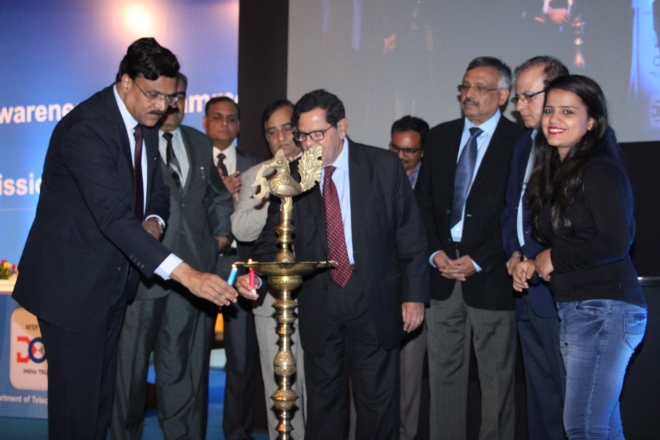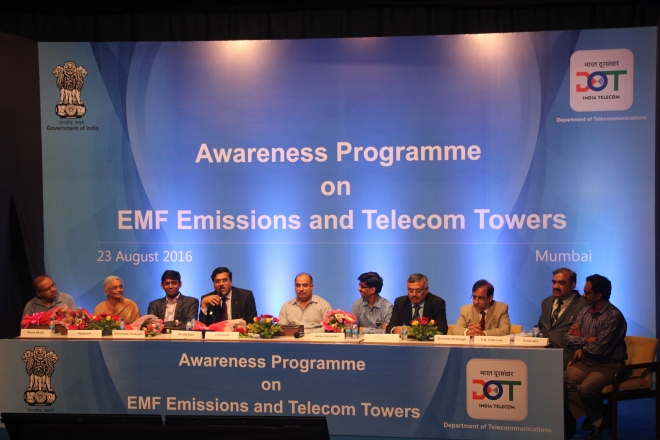A public outreach and awareness program was organized under the aegis of Department of Telecommunications (DoT) on Electromagnetic Field (EMF) Emissions and Mobile Towers.

Delivering the inaugural address J S Deepak, Secretary, DoT, Ministry of Communications & IT, Govt. of India & Chairman, Telecom Commission, brought out the important role played by mobile telephony and various benefits derived from it, at an individual, social and national level. He emphasized that whether India grows at normal pace or it actually leapfrogs to become one of the most developed nation in coming decades, will inter-alia depend on how we embrace and harness wireless communication technologies.
He said that telecom towers are critical installations on which the backbone of wireless communication rests and unfounded apprehensions around EMF emissions and mobile towers have the potential to derail our growth story. The DoT Secretary said that there is no scientific evidence backing the claim that EMF radiation from mobile towers — which are below the safe limits prescribed by the International Commission on Non-Ionizing Radiation Protection (ICNIRP) and recommended by the World Health Organization (WHO) — can cause adverse health effects. The DoT has already prescribed strict precautionary norms for exposure limit for the Radio Frequency Field (Base Station Emissions) which is ten times more stringent than the existing limits prescribed by ICNIRP and recommended by WHO. Our EMF norms are much stricter than what is followed by many developed nations, including the US, the UK and most parts of the European Union. Further, the Government of India has taken adequate steps to ensure that Telecommunications Service Providers strictly adhere to these prescribed norms, he added.
Dr R M Chaturvedi, DDG-CS, DoT, pointed out that WHO has referred to approximately 25,000 studies, conducted around the world over the past 30 years, and based on an in-depth review of scientific literature, has concluded, “Despite the feeling of some people that more research needs to be done, scientific knowledge in this area is now more extensive than for most chemicals. Current evidence does not confirm the existence of any health consequences from exposure to low level electromagnetic fields.”
He also referred to EMF Project established by WHO, in which over 50 national authorities and 8 international organizations are involved. Together, since 1996, they have been reviewing scientific information to provide scientifically sound and objective answers to public concerns about thepossible hazards of low-level electromagnetic fields. He has observed that despite extensive research, to date there is no evidence to conclude that exposure to low-level electromagnetic fields is harmful to human health.
A Committee, formed at the behest of Allahabad High Court comprising experts from five IITs, AIIMS (Delhi), Indian Council of Medical Research (ICMR) and Indian Institute of Toxicology Research, Lucknow, has also on the basis of scientific evidence, studies and reports available, found that there is no conclusive evidence about the stated dangers of EMF radiation from mobile BTS tower.
Shivendra Bhatnagar, Senior DDG, Telecom Enforcement Resource & Monitoring (TERM) unit, said, ” Strict monitoring and enforcement mechanism has been put in place by the DoT for EMF-related compliance. In case any BTS site is found to violate prescribed EMF norms, actions are taken to put a penalty of Rs 10 lakh per BTS per incidence, including closing of BTS site in case violation persists.
Several High Courts, including the High Courts of Punjab & Haryana, Madras, Kerala, Gujarat and Allahabad in cases related to issue of effects of the radiation from cellphone towers have given judgments whereby they have dismissed petitions, where the mobile tower installations were challenged in various localities, including residential, on grounds of health effects of EMF radiation.”
V K Gautam, Principal Secretary, IT, Govt of Maharashtra, emphasized on the need of creating robust infrastructure in order to enhance the quality of broadband and calling services.
Dr Suresh Attili from Grace Cancer Foundation and Dr. Anirudh Kohli, Head of Radiology, Breach Candy Hospital, Mumbai, endorsed the fact that scientific studies have not been able to conclude that EMF emissions from mobile towers can cause health hazards. Mobile towers in India have been found to be completely safe and emissions well within the prescribed Government of India norms. The program concluded with an interactive Q&A session between senior government officials and participants from civil society, RWA’s and the media.
Read the full article here.

